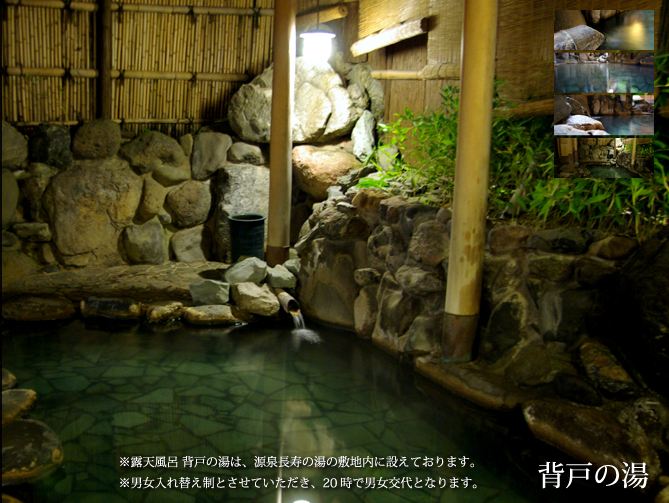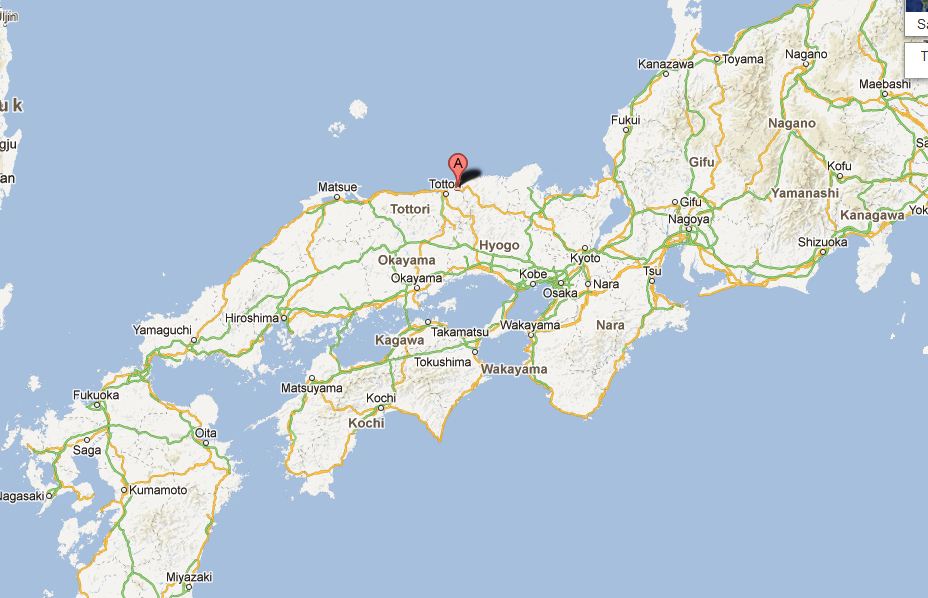During these chilly winter months, there’s nothing quite like taking a dip in a natural hot spring and feeling your aching muscles soften like a pan of chocolate on a warm log cabin stove. But if you’ve seen every onsen (hot spring) that Japan has to offer or are simply wishing to avoid the crowds of like-minded visitors, locating a new place to bathe isn’t easy. Thankfully, help is at hand.
In an article over at Yahoo! Japan’s R25 digital magazine, a member of the Nihon Onsen Kyoukai (Japan Hot Spring Association) lets readers in on three little-known, not to mention rather unusual, hot spring locations that are sure to leave you with plenty of tales to tell family and friends. All the juicy info after the break.
With more than 3,000 hot spring locations scattered across Japan, it’s little wonder that we’ve all by now seen plenty of photos of bathing monkeys, steaming pools of water surrounded by undisturbed snow, or young ladies wrapped in towels taking a dip. But for the onsen extraordinaire, once the spots listed in all of the travel guides have been checked off, where is there left to turn? The Japan Hot Springs Association’s Fuyama-san has some very interesting recommendations:
“If you’re looking for something a little different, I recommend Toyotomi Onsen, situated at the northernmost point of Hokkaido, which is known for being a ‘petroleum hot spring’.”
Did she just say petroleum? As in the stuff we pump into our cars to help us get to Starbucks faster!?
“That’s right; there’s a very thin layer of petroleum oil floating on top of the spring water here, which means there’s an ever-so-slight whiff of gasoline. But the oil in the water is actually very good for skin conditions, and so hot spring fans from all over the country flock here each year.”
▼If you’re looking for “remote countryside”, Toyotomi is definitely the place!
Although it may sound far-fetched at first, a quick search online in Japanese for “Toyotomi onsen” does indeed yield numerous independently written blogs, complete with photos, detailing how Toyotomi’s hot spring water helped cure a variety of minor skin conditions. Although bathing in water whose surface is covered in petroleum might not sound especially appealing, the Japan Hot Springs Association’s representative assures her readers that it’s far less oily than we might imagine, and when we consider how many people use Vaseline- a petroleum jelly based product applied directly to the skin – on a regular basis, there really is nothing to be afraid of.
Next up is Akita Prefecture’s Tamagawa onsen resort, which Fuyama-san informs us contains springs whose water – with a pH of 1.1 – is by far Japan’s most acidic. But at 10 times the acidity of ordinary lemon juice, can that really be a good thing?
“It certainly makes your skin tingle all over! The water here is said to be beneficial to those with high blood pressure or suffering from arteriosclerosis (the hardening of the arteries). For this reason, the resort has many visitors who come to stay for long periods of time, and there’s even self-catering accommodation available.”
With barren surrounds and rocks scattered everywhere, Tamagawa may not appeal to those partial to a dip in the tub with a rubber duck and a glass of red wine, but with 100% natural spring water gushing up through the ground and tingling every inch of your body, you’ll have plenty to tell your friends about when you get home. Getting the water in your eyes or an unhealed paper cut, however, is probably not the best idea.
Finally, Fuyama-san introduces us to a hot spring resort that, while not boasting petroleum-membrane or skin-tingling water, has a very special, centuries-old custom of its own. Located in Tottori Prefecture in southern Japan, the Iwai Onsen resort invites visitors to sing a little while taking a dip!
“With over 1,200 years of history, this resort has a custom known as yu kamuri (lit. “hot water cap”). After soaking in the water for a while, guests sing what is known as the yu kamuri song while placing their hand towel on top of their head and ladling the hot water over it. It’s said that this custom helps the effects of the water spread through the entire body.”
As R25’s reporter writes, Tottori prefecture is not exactly renown for its onsen resorts since, next to Okinawa, the prefecture has the smallest number of natural hot springs in the country. But it’s perhaps for this very reason that the people of Tottori enjoy their baths a little more than most, and, let’s be honest, who among us hasn’t sung in the bath or shower at least a couple of times?
If any of you are fortunate enough to have paid any of these locations a visit, we’d love to hear your impressions! Let us know what you thought of the resorts in the comments section below or via our Facebook page!
Source: Yahoo! Japan R25
▼Tottori Prefecture is Japan’s least populous prefecture.
Maps via Google Maps




 Hyotan Onsen – Japan’s only hot spring with three Michelin stars
Hyotan Onsen – Japan’s only hot spring with three Michelin stars Five awesome hot springs in Taiwan (one of them has been on fire for 300 years!)
Five awesome hot springs in Taiwan (one of them has been on fire for 300 years!) The 10 best Japanese hot spring resorts locals want to go back to again and again
The 10 best Japanese hot spring resorts locals want to go back to again and again Five of Japan’s most unique snow-covered hot spring bathing sites
Five of Japan’s most unique snow-covered hot spring bathing sites Free onsen! Kyushu resort shipping hot spring water to homes across Japan in thank-you program
Free onsen! Kyushu resort shipping hot spring water to homes across Japan in thank-you program Tokyo cafe offers all-you-can-eat pancakes for less than ten bucks!
Tokyo cafe offers all-you-can-eat pancakes for less than ten bucks! That time Seiji called JASRAC to ask why he didn’t get paid royalties for his song being on TV
That time Seiji called JASRAC to ask why he didn’t get paid royalties for his song being on TV Eating all the cat treats at Japanese convenience store Family Mart
Eating all the cat treats at Japanese convenience store Family Mart Pikachu-ear engagement rings and Pokémon wedding rings for him and her can now be yours【Photos】
Pikachu-ear engagement rings and Pokémon wedding rings for him and her can now be yours【Photos】 7-Eleven Japan’s ramen-cooking robot whipped us up a bowl of noodles【Taste test】
7-Eleven Japan’s ramen-cooking robot whipped us up a bowl of noodles【Taste test】 Harajuku’s new permanent Tamagotchi shop is filled with cuteness and a surprising lack of poop
Harajuku’s new permanent Tamagotchi shop is filled with cuteness and a surprising lack of poop First Kit Kat Chocolatery shop with cafe opens in Kyoto! New Chocolatery items released too
First Kit Kat Chocolatery shop with cafe opens in Kyoto! New Chocolatery items released too The roller slide of terror: Treetop fun ride for kids is a terrifying experience for adult butts
The roller slide of terror: Treetop fun ride for kids is a terrifying experience for adult butts Cup Noodle tries an authentic Jiro-style ramen, but something’s not quite right
Cup Noodle tries an authentic Jiro-style ramen, but something’s not quite right 17 new designs unveiled in round two of regional Japanese license plates
17 new designs unveiled in round two of regional Japanese license plates Starbucks Japan ready to get Year of the Horse started with adorable drinkware and plushies【Pics】
Starbucks Japan ready to get Year of the Horse started with adorable drinkware and plushies【Pics】 7 great places to see Mt. Fuji from without having to climb it
7 great places to see Mt. Fuji from without having to climb it Cyberpunk anime meets traditional culture in Ghost in the Shell gold leaf Japanese changing screens
Cyberpunk anime meets traditional culture in Ghost in the Shell gold leaf Japanese changing screens Hayao Miyazaki says Happy New Year to Studio Ghibli fans with new art for Year of the Horse
Hayao Miyazaki says Happy New Year to Studio Ghibli fans with new art for Year of the Horse Hello Kitty Choco Egg figures are an adorable trip through three periods of Japanese pop culture【Pics】
Hello Kitty Choco Egg figures are an adorable trip through three periods of Japanese pop culture【Pics】 We found possibly the quietest Japanese-style hotel in Tokyo’s bustling Shinjuku district
We found possibly the quietest Japanese-style hotel in Tokyo’s bustling Shinjuku district Sumo Sanrio! Hello Kitty and pals team up with Japan Sumo Association for new merch【Pics】
Sumo Sanrio! Hello Kitty and pals team up with Japan Sumo Association for new merch【Pics】 Japan’s oldest largetooth sawfish in captivity back on display in Mie Prefecture
Japan’s oldest largetooth sawfish in captivity back on display in Mie Prefecture More Than a Capsule Stay: Why Solo Travelers Choose “global cabin Yokohama Chinatown”
More Than a Capsule Stay: Why Solo Travelers Choose “global cabin Yokohama Chinatown” 7-Eleven Japan starts new temporary luggage storage service in over 300 branches
7-Eleven Japan starts new temporary luggage storage service in over 300 branches Disillusionment at Tsukiji’s tourist-target prices led us to a great ramen restaurant in Tokyo
Disillusionment at Tsukiji’s tourist-target prices led us to a great ramen restaurant in Tokyo Starbucks teams up with 166-year-old Kyoto doll maker for Year of the Horse decorations【Photos】
Starbucks teams up with 166-year-old Kyoto doll maker for Year of the Horse decorations【Photos】 Tokyo considering law requiring more trash cans following litter increase in heavily touristed area
Tokyo considering law requiring more trash cans following litter increase in heavily touristed area Tokyo’s Tsukiji sushi neighborhood asks tour groups to stay away for the rest of the month
Tokyo’s Tsukiji sushi neighborhood asks tour groups to stay away for the rest of the month Tokyo event lets you travel back in time, for free, to celebrate 100 years since Showa era start
Tokyo event lets you travel back in time, for free, to celebrate 100 years since Showa era start Sanrio theme park in Japan announces plans to expand into a Sanrio resort
Sanrio theme park in Japan announces plans to expand into a Sanrio resort Japan may add Japanese language proficiency, lifestyle classes to permanent foreign resident requirements
Japan may add Japanese language proficiency, lifestyle classes to permanent foreign resident requirements Stamina-destroying “Paralysis Noodles” are Tokyo’s newest over-the-top ramen innovation
Stamina-destroying “Paralysis Noodles” are Tokyo’s newest over-the-top ramen innovation Survey asks foreign tourists what bothered them in Japan, more than half gave same answer
Survey asks foreign tourists what bothered them in Japan, more than half gave same answer Japan’s human washing machines will go on sale to general public, demos to be held in Tokyo
Japan’s human washing machines will go on sale to general public, demos to be held in Tokyo Japan’s deadliest food claims more victims, but why do people keep eating it for New Year’s?
Japan’s deadliest food claims more victims, but why do people keep eating it for New Year’s? We deeply regret going into this tunnel on our walk in the mountains of Japan
We deeply regret going into this tunnel on our walk in the mountains of Japan Studio Ghibli releases Kodama forest spirits from Princess Mononoke to light up your home
Studio Ghibli releases Kodama forest spirits from Princess Mononoke to light up your home Major Japanese hotel chain says reservations via overseas booking sites may not be valid
Major Japanese hotel chain says reservations via overseas booking sites may not be valid Put sesame oil in your coffee? Japanese maker says it’s the best way to start your day【Taste test】
Put sesame oil in your coffee? Japanese maker says it’s the best way to start your day【Taste test】 No more using real katana for tourism activities, Japan’s National Police Agency says
No more using real katana for tourism activities, Japan’s National Police Agency says Starbucks Japan reveals new sakura drinkware collection, inspired by evening cherry blossoms
Starbucks Japan reveals new sakura drinkware collection, inspired by evening cherry blossoms Updated cherry blossom forecast shows extra-long sakura season for Japan this year
Updated cherry blossom forecast shows extra-long sakura season for Japan this year Love Japanese hot springs? At Nakadake Onsen in Hokkaido, you can dig your own!
Love Japanese hot springs? At Nakadake Onsen in Hokkaido, you can dig your own! Love hot springs and tattoos? You won’t want to miss this onsen paradise near Tokyo!
Love hot springs and tattoos? You won’t want to miss this onsen paradise near Tokyo! Onsen trivia! Finding the hottest, highest, and healthiest hot springs in Japan
Onsen trivia! Finding the hottest, highest, and healthiest hot springs in Japan Dog’s Onsen: Give your pet a traditional Japanese hot spring bath
Dog’s Onsen: Give your pet a traditional Japanese hot spring bath Is the fountain of youth located in Japan? New study supports beauty claims of famous Japanese hot spring
Is the fountain of youth located in Japan? New study supports beauty claims of famous Japanese hot spring Capybara hot springs are back: Rodent-friendly onsen now available all over Japan
Capybara hot springs are back: Rodent-friendly onsen now available all over Japan 2020’s most popular hot springs in Japan, as ranked by Japanese travelers
2020’s most popular hot springs in Japan, as ranked by Japanese travelers 2018 Top 20 Day Trip Onsen Hot Spring and Spa Ranking in Japan
2018 Top 20 Day Trip Onsen Hot Spring and Spa Ranking in Japan Hot springs website reveals the most popular user-picked onsen in all of northern Japan
Hot springs website reveals the most popular user-picked onsen in all of northern Japan Secret tent onsen in the forest is one of the most unusual hot springs in Japan
Secret tent onsen in the forest is one of the most unusual hot springs in Japan Japan’s most famous hot spring resort runs ad telling us to go to…a different hot spring resort
Japan’s most famous hot spring resort runs ad telling us to go to…a different hot spring resort Japanese onsen stand is part gas station, part hot spring vending machine
Japanese onsen stand is part gas station, part hot spring vending machine Japan’s top five retro hot springs for a time trip back to the onsen past, as chosen by travelers
Japan’s top five retro hot springs for a time trip back to the onsen past, as chosen by travelers The 10 best hotel hot springs in Japan, as chosen by Japanese travelers
The 10 best hotel hot springs in Japan, as chosen by Japanese travelers Chocolate hot spring bath opens in Japan, allows swimsuits, mixed-gender bathing
Chocolate hot spring bath opens in Japan, allows swimsuits, mixed-gender bathing Soak in a secret Japanese onsen hot spring…in a dilapidated old building
Soak in a secret Japanese onsen hot spring…in a dilapidated old building
Leave a Reply